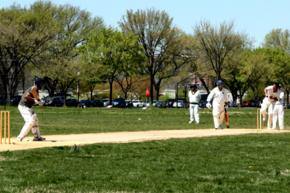Cricket in a ‘Spot’

The ugly spectre of match fixing is raising its head again. After the heady days of the 1990s when Hansie Cronje (South Africa), Mohammed Azharuddin (India) and Salim Malik (Pakistan) were shown the door for Match fixing, the ghosts have returned to the field of cricket once more albeit in a new avatar. The news channels have been having a field day with allegations of spot fixing by the touring Pakistani team in England. Cricket is in the midst of a “spot” controversy now.
First of all let us get to understand what is spot fixing and how different it is from match fixing. Match fixing is where the outcome of a match is fixed to favour a team in the league matches or round robins of a tournament. The famous example is that of Essex throwing away a match in 1994 against Lancashire in the Sunday League championship, in return for a victory in the County Championship match and the title the next day. While no one was ever punished, it did rock the Test and County cricket board (the predecessor of ECB) at that time. By 1999 the Cronjegate (if it can be called that) surfaced and the ICC stepped in to root out the problem. It managed to do so to an extent until the T20 format came into force!
Spot fixing is about fixing a part of the match. More precisely it is fixing an over or a crucial moment of the match. For example a bowler will bowl deliberate no balls in particular over(s), or a batsman of high calibre will give a chance in the slip cordon before scoring say 20 runs. This is very difficult to detect as it is seen as a part of the match and there is hardly any room for pointing fingers. The illegal betting dens in India, Middle East, Pakistan and to an extent the UK have been all involved in this spot fixing.
While Pakistani players have been accused of doing that in the recent tours of Australia, and now England, it is actually Essex once again which was involved in the spot fixing row in May this year. Danish Kaneria (Pakistan) and Mervyn Westfield (England) were two players allegedly involved in the spot fixing row and were arrested by the police and later released on bail. Mohammed Asif, Mohammed Amir and Salman Butt have been the latest to get nabbed by Scotland Yard after a bookie revealed his involvement with the players in spot fixing.
Many allege that spot fixing is rampant in India, Sri Lanka and Pakistan. However, the problem is more deep rooted than just the sub continental countries. The fact that there is lot of money now in these countries is not helping matters and the absence of official betting agencies makes the matter even worse. (England hides under the garb that betting is legal in that country, but no headlines are made when their own counties are involved in spot fixing.)
Can spot fixing be actually done? That is the moot question. Having played cricket for a number of years and watched it from close quarters, I can make a bold claim, that this is not possible without the captain of the team being involved. It is the captain who decides which bowler gets to bowl, the batting order, etc, so without his knowledge it is nearly impossible to achieve the desired results of spot fix. In addition to that, you need at least 3-4 key players on your side to play the ball with spot fixing. How else could you conjure up no-balls or missed catches without them being on your side? The recent case of Kamran Akmal fumbling the easiest of chances, Asif bowling no balls at regular intervals, all bring to mind the same question – is this real or fixed!
Money corrupts, is an old adage and unless the ICC and BCCI take strong steps, this will bring the downfall of cricket. For ICC it is in international matter, but for BCCI it is more important as their fat cheques are due to the popularity of the game and the huge fan following. If this disease is not weeded out, the fans will quickly turn away from the sport as doubts will start creeping about the records, wins and loses. Given that ICC is headed by Sharad Pawar, the onus on BCCI is much stronger to come forward with a plan to root this out in India itself. BCCI should take the lead with the Government and make it clear that any player found to be working with the bookies will face immediate life ban from all forms of cricket and criminal proceedings will be initiated.
But will the mandarins in BCCI have the guts to do so? Given the political way of life they are accustomed to and the attitude of turning a blind eye to happenings seems like the ostrich syndrome. It won’t be long before sponsors start pulling out if this goes on. Master Blaster Sachin Tendulkar made a telling comment that never ever has anybody approached the Indian team. Maybe he has forgotten the Mohammed Azharuddin incident or funny enough; the cricketers in India are now making so much money with endorsements that they may probably be not tempted by the spot bookies’ offerings. But the same is not the case with every player in the subcontinent. Most of them come from a very hard economic background and given the selection process is most whimsical in countries like Pakistan and Bangladesh, it is no wonder that the players are lured into big money by the spot bookies.
While this may sound a bit farfetched, ICC needs to look at the option of pay parity across member nations (based on local pay scales as well) and also regarding the structure of cricket and selection boards in these countries. Maybe then we might see some sanity back into the game. The game has a huge fan following and if ICC wants Cricket to flourish, then they have to take some hard decisions and not politically motivated ones. Only then will Cricket be “spotless”.
The ugly spectre of match fixing is raising its head again. After the heady days of the 1990s when Hansie Cronje (South Africa), Mohammed Azharuddin (India) and Salim Malik (Pakistan) were shown the door for Match fixing, the ghosts have returned to the field of cricket once more albeit in a new...
The ugly spectre of match fixing is raising its head again. After the heady days of the 1990s when Hansie Cronje (South Africa), Mohammed Azharuddin (India) and Salim Malik (Pakistan) were shown the door for Match fixing, the ghosts have returned to the field of cricket once more albeit in a new avatar. The news channels have been having a field day with allegations of spot fixing by the touring Pakistani team in England. Cricket is in the midst of a “spot” controversy now.
First of all let us get to understand what is spot fixing and how different it is from match fixing. Match fixing is where the outcome of a match is fixed to favour a team in the league matches or round robins of a tournament. The famous example is that of Essex throwing away a match in 1994 against Lancashire in the Sunday League championship, in return for a victory in the County Championship match and the title the next day. While no one was ever punished, it did rock the Test and County cricket board (the predecessor of ECB) at that time. By 1999 the Cronjegate (if it can be called that) surfaced and the ICC stepped in to root out the problem. It managed to do so to an extent until the T20 format came into force!
Spot fixing is about fixing a part of the match. More precisely it is fixing an over or a crucial moment of the match. For example a bowler will bowl deliberate no balls in particular over(s), or a batsman of high calibre will give a chance in the slip cordon before scoring say 20 runs. This is very difficult to detect as it is seen as a part of the match and there is hardly any room for pointing fingers. The illegal betting dens in India, Middle East, Pakistan and to an extent the UK have been all involved in this spot fixing.
While Pakistani players have been accused of doing that in the recent tours of Australia, and now England, it is actually Essex once again which was involved in the spot fixing row in May this year. Danish Kaneria (Pakistan) and Mervyn Westfield (England) were two players allegedly involved in the spot fixing row and were arrested by the police and later released on bail. Mohammed Asif, Mohammed Amir and Salman Butt have been the latest to get nabbed by Scotland Yard after a bookie revealed his involvement with the players in spot fixing.
Many allege that spot fixing is rampant in India, Sri Lanka and Pakistan. However, the problem is more deep rooted than just the sub continental countries. The fact that there is lot of money now in these countries is not helping matters and the absence of official betting agencies makes the matter even worse. (England hides under the garb that betting is legal in that country, but no headlines are made when their own counties are involved in spot fixing.)
Can spot fixing be actually done? That is the moot question. Having played cricket for a number of years and watched it from close quarters, I can make a bold claim, that this is not possible without the captain of the team being involved. It is the captain who decides which bowler gets to bowl, the batting order, etc, so without his knowledge it is nearly impossible to achieve the desired results of spot fix. In addition to that, you need at least 3-4 key players on your side to play the ball with spot fixing. How else could you conjure up no-balls or missed catches without them being on your side? The recent case of Kamran Akmal fumbling the easiest of chances, Asif bowling no balls at regular intervals, all bring to mind the same question – is this real or fixed!
Money corrupts, is an old adage and unless the ICC and BCCI take strong steps, this will bring the downfall of cricket. For ICC it is in international matter, but for BCCI it is more important as their fat cheques are due to the popularity of the game and the huge fan following. If this disease is not weeded out, the fans will quickly turn away from the sport as doubts will start creeping about the records, wins and loses. Given that ICC is headed by Sharad Pawar, the onus on BCCI is much stronger to come forward with a plan to root this out in India itself. BCCI should take the lead with the Government and make it clear that any player found to be working with the bookies will face immediate life ban from all forms of cricket and criminal proceedings will be initiated.
But will the mandarins in BCCI have the guts to do so? Given the political way of life they are accustomed to and the attitude of turning a blind eye to happenings seems like the ostrich syndrome. It won’t be long before sponsors start pulling out if this goes on. Master Blaster Sachin Tendulkar made a telling comment that never ever has anybody approached the Indian team. Maybe he has forgotten the Mohammed Azharuddin incident or funny enough; the cricketers in India are now making so much money with endorsements that they may probably be not tempted by the spot bookies’ offerings. But the same is not the case with every player in the subcontinent. Most of them come from a very hard economic background and given the selection process is most whimsical in countries like Pakistan and Bangladesh, it is no wonder that the players are lured into big money by the spot bookies.
While this may sound a bit farfetched, ICC needs to look at the option of pay parity across member nations (based on local pay scales as well) and also regarding the structure of cricket and selection boards in these countries. Maybe then we might see some sanity back into the game. The game has a huge fan following and if ICC wants Cricket to flourish, then they have to take some hard decisions and not politically motivated ones. Only then will Cricket be “spotless”.









Leave a Comment